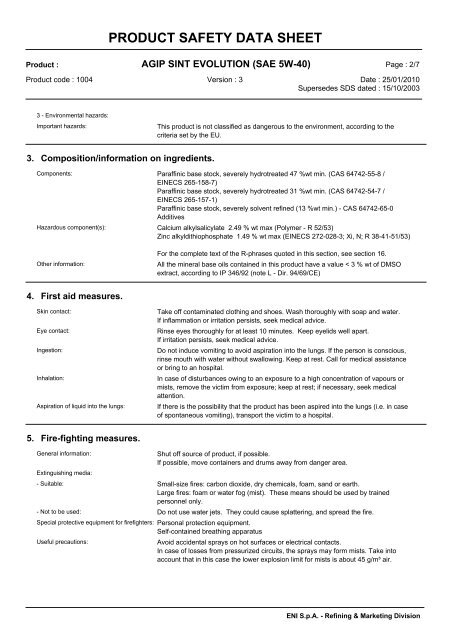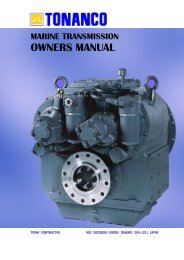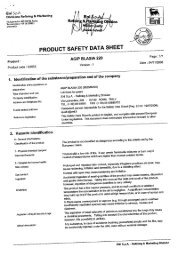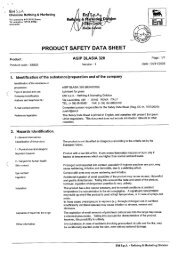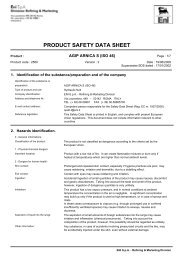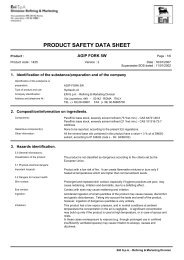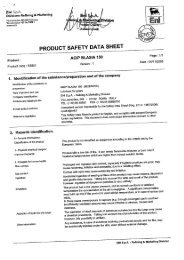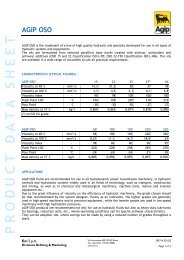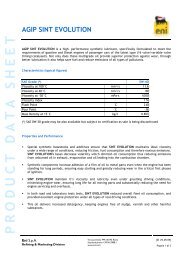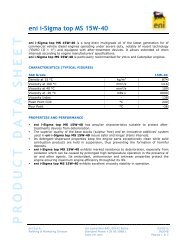AGIP SINT EVOLUTION (SAE 5W-40). - TransDiesel
AGIP SINT EVOLUTION (SAE 5W-40). - TransDiesel
AGIP SINT EVOLUTION (SAE 5W-40). - TransDiesel
You also want an ePaper? Increase the reach of your titles
YUMPU automatically turns print PDFs into web optimized ePapers that Google loves.
PRODUCT SAFETY DATA SHEET<br />
Product :<br />
Product code : 1004<br />
<strong>AGIP</strong> <strong>SINT</strong> <strong>EVOLUTION</strong> (<strong>SAE</strong> <strong>5W</strong>-<strong>40</strong>)<br />
Version : 3<br />
Page : 2/7<br />
Date : 25/01/2010<br />
Supersedes SDS dated : 15/10/2003<br />
3 - Environmental hazards:<br />
Important hazards:<br />
This product is not classified as dangerous to the environment, according to the<br />
criteria set by the EU.<br />
3. Composition/information on ingredients.<br />
Components: Paraffinic base stock, severely hydrotreated 47 %wt min. (CAS 64742-55-8 /<br />
EINECS 265-158-7)<br />
Paraffinic base stock, severely hydrotreated 31 %wt min. (CAS 64742-54-7 /<br />
EINECS 265-157-1)<br />
Paraffinic base stock, severely solvent refined (13 %wt min.) - CAS 64742-65-0<br />
Additives<br />
Hazardous component(s): Calcium alkylsalicylate 2.49 % wt max (Polymer - R 52/53)<br />
Zinc alkyldithiophosphate 1.49 % wt max (EINECS 272-028-3; Xi, N; R 38-41-51/53)<br />
Other information:<br />
For the complete text of the R-phrases quoted in this section, see section 16.<br />
All the mineral base oils contained in this product have a value < 3 % wt of DMSO<br />
extract, according to IP 346/92 (note L - Dir. 94/69/CE)<br />
4. First aid measures.<br />
Skin contact:<br />
Eye contact:<br />
Ingestion:<br />
Inhalation:<br />
Aspiration of liquid into the lungs:<br />
Take off contaminated clothing and shoes. Wash thoroughly with soap and water.<br />
If inflammation or irritation persists, seek medical advice.<br />
Rinse eyes thoroughly for at least 10 minutes. Keep eyelids well apart.<br />
If irritation persists, seek medical advice.<br />
Do not induce vomiting to avoid aspiration into the lungs. If the person is conscious,<br />
rinse mouth with water without swallowing. Keep at rest. Call for medical assistance<br />
or bring to an hospital.<br />
In case of disturbances owing to an exposure to a high concentration of vapours or<br />
mists, remove the victim from exposure; keep at rest; if necessary, seek medical<br />
attention.<br />
If there is the possibility that the product has been aspired into the lungs (i.e. in case<br />
of spontaneous vomiting), transport the victim to a hospital.<br />
5. Fire-fighting measures.<br />
General information:<br />
Extinguishing media:<br />
Shut off source of product, if possible.<br />
If possible, move containers and drums away from danger area.<br />
- Suitable: Small-size fires: carbon dioxide, dry chemicals, foam, sand or earth.<br />
Large fires: foam or water fog (mist). These means should be used by trained<br />
personnel only.<br />
- Not to be used: Do not use water jets. They could cause splattering, and spread the fire.<br />
Special protective equipment for firefighters: Personal protection equipment.<br />
Self-contained breathing apparatus<br />
Useful precautions:<br />
Avoid accidental sprays on hot surfaces or electrical contacts.<br />
In case of losses from pressurized circuits, the sprays may form mists. Take into<br />
account that in this case the lower explosion limit for mists is about 45 g/m³ air.<br />
ENI S.p.A. - Refining & Marketing Division


